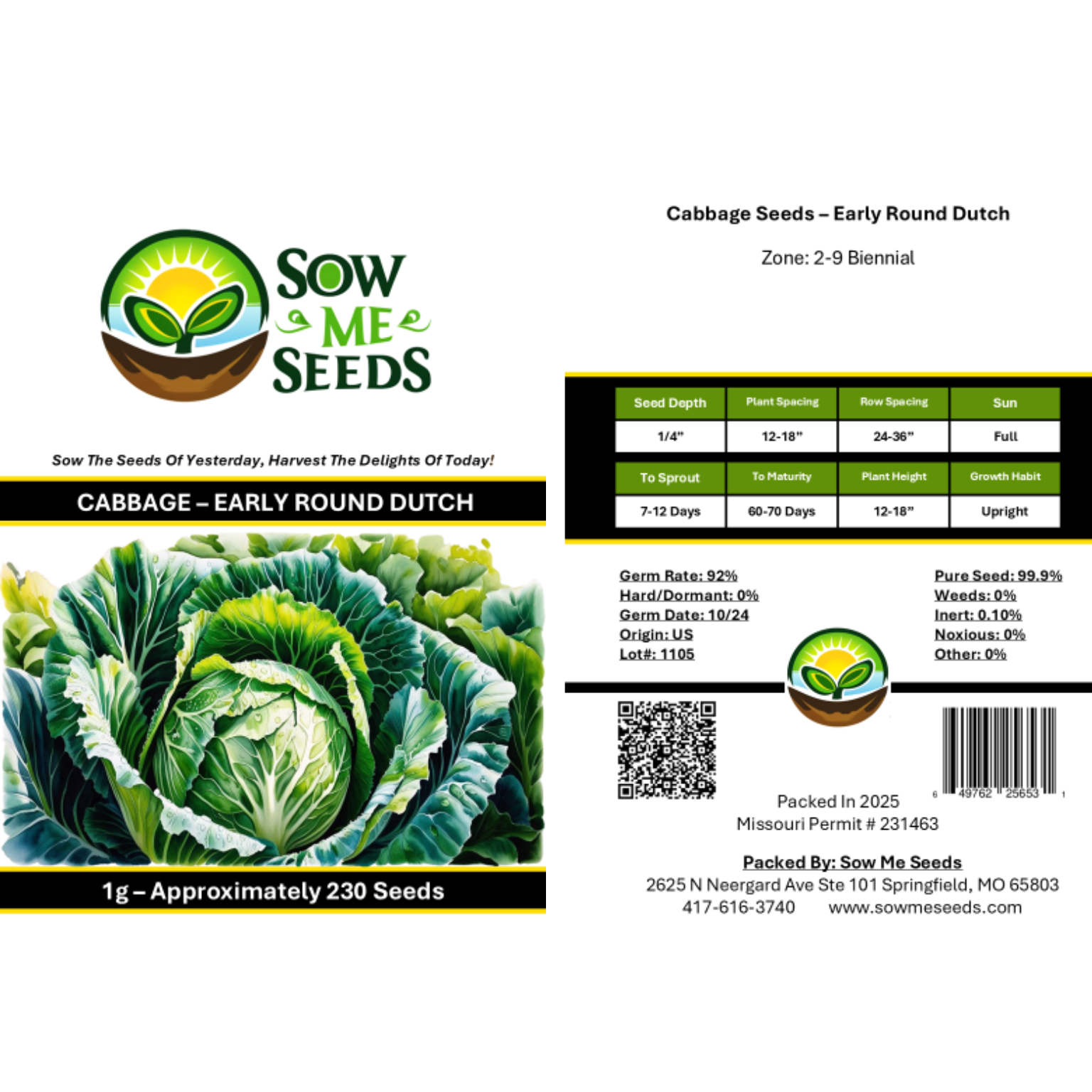- Hardiness Zone: 2-9 Biennial Typically Grown As An Annual
Seed Depth: 1/4 inch
Seed Spacing: 12–18 inches
Row Spacing: 24–36 inches
Sunlight: Full sun
Days to Sprout: 7–12 days
Days to Maturity: 60–70 days
Growth Habit: Upright, compact annual
Sunlight: Thrives in full sun, requiring at least 6–8 hours of direct sunlight daily.
Soil Type: Prefers fertile, well-drained soil with a pH of 6.0–7.5. Amend soil with compost or organic matter to boost fertility.
When to Plant: Start seeds indoors 6–8 weeks before the last frost. Transplant outdoors when seedlings are 4–6 weeks old and the danger of frost has passed.
Direct Sowing: In warmer climates, sow seeds directly outdoors in early spring or late summer for a fall harvest.
Indoor Sowing: Sow seeds 1/4 inch deep in seed trays or pots. Transplant when seedlings have 2–3 sets of true leaves.
Succession Planting: Sow every 2–3 weeks for a continuous harvest during the growing season.
Watering: Water consistently to keep soil evenly moist but not waterlogged. Mulch around plants to retain moisture and regulate temperature.
Fertilizing: Apply a balanced fertilizer at planting and again mid-season to encourage head formation.
Pruning: Remove yellowing or damaged leaves to prevent disease and encourage healthy growth.
Pest and Disease Control: Watch for cabbage worms, aphids, and flea beetles. Use row covers or organic pest control methods as needed.
When to Harvest: Harvest when heads are firm, compact, and reach 4–6 inches in diameter, typically 60–70 days after planting.
How to Harvest: Use a sharp knife to cut heads at the base, leaving outer leaves for possible secondary growth.
Seed Collection: Allow plants to bolt and form seed pods in their second year. Collect seeds from dried pods.
Storing Seeds: Store seeds in an airtight container in a cool, dry place.
Why You’ll Love It
Early Maturing: Harvest in just over two months — perfect for short growing seasons or early spring planting.
Cold Tolerant: Thrives in cool weather and can handle light frosts, making it ideal for spring and fall crops.
Compact Growth: Smaller heads on tidy plants make it a great choice for raised beds or small-space gardens.
Delicious: Sweet, crisp leaves with a classic cabbage flavor — great for fresh eating or cooked dishes.
Plant Characteristics
Height: 12–18 inches
Growth Habit: Compact rosette with a dense, rounded central head
Head Type: Firm, round, pale green heads, 4–6 inches across
Days to Maturity: 60–70 days
Hardiness: Cool-season biennial grown as an annual
Flavor and Culinary Uses
Flavor: Mild, sweet, and crunchy when raw; soft and slightly nutty when cooked
Culinary Uses: Excellent for coleslaw, cabbage rolls, soups, stir-fries, and small-batch sauerkraut
Companion Planting Tips
Good Companions: Onions, beets, celery, and chamomile
Avoid Planting Near: Strawberries, tomatoes, or pole beans
Bonus Benefit: Deters some pests and grows well in crop rotations with leafy greens
Common Issues and Solutions
Cabbage Worms: Use floating row covers or introduce beneficial insects like parasitic wasps
Splitting Heads: Harvest promptly once heads feel firm to prevent cracking after heavy rains
Stunted Growth: Avoid overcrowding and provide consistent water during head formation
Seeds Per Packet
| 1g | Approximately 230 |
| 5g | Approximately 1,150 |
Why You’ll Love It
Early Maturing: Harvest in just over two months — perfect for short growing seasons or early spring planting.
Cold Tolerant: Thrives in cool weather and can handle light frosts, making it ideal for spring and fall crops.
Compact Growth: Smaller heads on tidy plants make it a great choice for raised beds or small-space gardens.
Delicious: Sweet, crisp leaves with a classic cabbage flavor — great for fresh eating or cooked dishes.
Plant Characteristics
Height: 12–18 inches
Growth Habit: Compact rosette with a dense, rounded central head
Head Type: Firm, round, pale green heads, 4–6 inches across
Days to Maturity: 60–70 days
Hardiness: Cool-season biennial grown as an annual
Flavor and Culinary Uses
Flavor: Mild, sweet, and crunchy when raw; soft and slightly nutty when cooked
Culinary Uses: Excellent for coleslaw, cabbage rolls, soups, stir-fries, and small-batch sauerkraut
Companion Planting Tips
Good Companions: Onions, beets, celery, and chamomile
Avoid Planting Near: Strawberries, tomatoes, or pole beans
Bonus Benefit: Deters some pests and grows well in crop rotations with leafy greens
Common Issues and Solutions
Cabbage Worms: Use floating row covers or introduce beneficial insects like parasitic wasps
Splitting Heads: Harvest promptly once heads feel firm to prevent cracking after heavy rains
Stunted Growth: Avoid overcrowding and provide consistent water during head formation
Seeds Per Packet
| 1g | Approximately 230 |
| 5g | Approximately 1,150 |







Share and get 15% off!
Simply share this product on one of the following social networks and you will unlock 15% off!